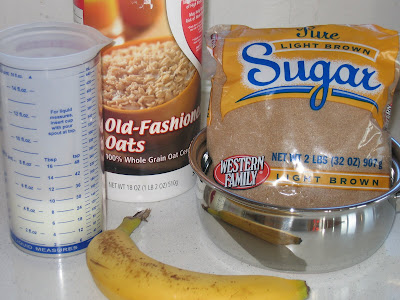About a year ago, I became obsessed with scones. I can't really explain why, other than that a) they're easy to make, and b) you can put chocolate in them. I started doing a ton of research and watched a bazillion videos on Expert Village, many that were little old British grandmas making their century old family scone recipe. I soon realized that the big debate with scones seems to be the fat. Do you use butter or margarine? I even found one recipe that bypassed them both and used olive oil. (By the way, I tried that recipe. I would only recommend using olive oil when making a savory scone, like garlic and rosemary. I used it in a raspberry scone recipe and all I could taste was the oil. Blegh!)
The other debate was how to incorporate the fat. Pastry cutter or by hand? Or by mixer, which is Ina Garten's method for her orange cranberry scones. Her theory is similar to the theory of pie crust. You want the butter to be COLD and to stay cold until it goes into the oven. If you touch the dough too much, the butter will start to melt. However, many of the British women I saw making scones used their hands and "rubbed" the butter into the flour mixture. Then there's the flour. Some use all-purpose, some use bread flour and some use pastry flour. Well, after a year of trial and error, I've concluded that there really is no right answer. It just depends on your personal taste.
See, I have baggage. When I lived in Seattle, there were two places that sparked my taste for scones: Hi Spot Cafe in Madrona, and Madison Park Cafe in Madison Park. In particular, Madison Park Cafe's lemon poppy seed scones, with that omigod-delish lemony glaze. And I think all of my scone endeavors have been an attempt to recreate these "perfect" scones. Dense, but moist, flavorful but not too sweet. My choice would be butter for the fat. Margarine tends to melt faster and makes the dough a little, well, doughy. And I prefer pastry flour, though, if you're in an experimental phase, that can get expensive. All-purpose works fine just for day to day use. But I have yet to figure out how to recreate the omigod-delish lemony glaze. It isn't a white, confectioners sugar concoction. It's a clear, shiny glaze brushed on, but it's not sticky and it tastes like tangy lemons. I think it
might be just lemon juice and sugar, simmered and reduced to a syrup, but I still need to do some experimenting.
Anyway, while visiting my parents, I was put in charge of making yummies for my mom's weekly quilting group. A group of women sitting around sewing? Could there be a more appropriate time for scones? I think not.
Normally when I make English Tea Scones, I use currants. However, my parents live in a rural town in southern Washington, so I had to rely on what I could find, and luckily I found dried cranberries. (For the record, I prefer currants in this particular recipe. Cranberries I prefer in in an orange scone. I think the flavors really compliment each other.)
so the recipe goes:
2 1/4 cups all-purpose flour
2 Tbs sugar
4 tsp baking powder
1/4 tsp salt
1/3 cup unsalted butter, cut into pieces
2 beaten eggs
3/4 cup whipping cream
1/2 cup currants or raisins
Milk
Sugar
First you mix the dry ingredients, then you cube the butter.

Cut in the butter using a pastry blender

Then mix the egg, heavy cream and the dried fruit (some recipes have you toss the fruit in flour and have you add it to the dough at the end, but I've done both and don't see much difference, and this method is much easier.)

Make a well in the center of the flour mixture and stir the wet ingredients in with a fork

Until it comes together

Then turn it out on a floured surface. Now, here's the tricky part. DON'T TOUCH IT. Well, okay, you can touch it a little. But don't overwork it or you'll make the butter angry! You don't even have to kneed it. Just flour your hands and quickly form it into a ball, and then roll it out so it looks like this

Or, you can roll it into a square (which I'm very bad at, so I stick with round) and, instead of using a biscuit cutter (or rim of a cup), you can cut them into wedges. But I prefer my scones round (you'll see why in a minute!). Brush the tops with milk and sprinkle with sanding sugar.

Bake at 400 degrees for 12-15 minutes, until they look like this

Now...to cut, or not to cut? I say cut. Or, fork split, which leaves all the nooks intact. Now, if I was just eating one of these with a cup of coffee, I'd probably just use a little jam or honey. But, since these were a yummy treat for a gaggle of women...

Yep. Real whipped cream and strawberry preserves. Forgive the blurry photo. My mom had a serious case of grabby hands. There is not time for pictures when there are women waiting for food! I should really know this.
The one thing about scones is that they don't keep. I've tried everything to get them to maintain their pizzaz for at least a couple days, but, like most baked goods, they're really best right out of the oven. However, I have had some success with wrapping them individually in waxed paper and freezing them. Then you can defrost one at a time. (Okay, three at a time. I mean, who can eat just one scone??)
 Looks wrong, I know, but just trust me. After the time in the fridge and the 18 hour rise, it'll look like this:
Looks wrong, I know, but just trust me. After the time in the fridge and the 18 hour rise, it'll look like this: And then, after you bake it (in a dutch oven, which I love!), it looks like this:
And then, after you bake it (in a dutch oven, which I love!), it looks like this: I know!!! It looks like something you'd get at an artisan bread bakery. And it's not all looks, either. It is so good. So much flavor; nice and dense (kinda like me). I was blown away. And after being blown away, I promptly made eggs:
I know!!! It looks like something you'd get at an artisan bread bakery. And it's not all looks, either. It is so good. So much flavor; nice and dense (kinda like me). I was blown away. And after being blown away, I promptly made eggs: Goat cheese, free-range eggs and chives from our garden. Yes, I am a domestic goddess. (Actually, I'm not, I just really like to stuff my face.)
Goat cheese, free-range eggs and chives from our garden. Yes, I am a domestic goddess. (Actually, I'm not, I just really like to stuff my face.)















